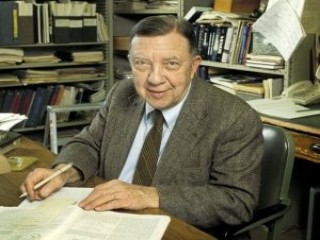
James Van Allen biography
Date of birth : 1914-09-07
Date of death : 2006-08-09
Birthplace : Mount Pleasant, Iowa, U.S.
Nationality : American
Category : Science and Technology
Last modified : 2011-09-14
Credited as : space scientist, radiation belts, Explorer 1, Explorer 3
0 votes so far
The Van Allen radiation belts were named after him, following the 1958 satellite missions (Explorer 1 and Explorer 3) in which Van Allen had argued that a Geiger counter should be used to detect charged particles.
Born in 1914, Van Allen was one of four children of James Alfred and Alma Olney Van Allen. He was raised in Mount Pleasant, Iowa, where he discovered a love for tinkering with machinery. His father, a lawyer, had instilled a hard-working ethic that helped Van Allen make it to the top of his high school graduating class. Out of high school, he attended Iowa Wesleyan College after failing the physical exam for the Naval Academy. At Iowa Wesleyan College he was recruited to work on the seismic and magnetic equipment for the 1934 expedition by Admiral Richard Byrd to Antarctica. The professor that Van Allen worked with on the project, Dr. Thomas Poulter, was second-in-command for the expedition and issued an invitation to Van Allen to join them. Since he was only 18 years old at the time, Van Allen's parents would not let him go.
After graduating summa cum laude from Iowa Wesleyan College with a degree in physics, Van Allen went on to get his masters and doctorate in physics from the University of Iowa. From 1939 to 1942, he worked as a research fellow at the Carnegie Institute in Washington, D.C. During that time he also worked at the Applied Physics Laboratory at Johns Hopkins University. World War II was in full force during that time and soon enough Van Allen was commissioned to join the U.S. Navy where he served as an ordnance and gunner officer as well as combat observer. His service in the military earned him four combat stars.
After his service in the war, Van Allen spent a few years supervising high-altitude research. In 1951, he joined the faculty at the University of Iowa as head of their department of physics and astronomy. There he worked with researchers to develop the "rockoon," a combination rocket and balloon. The previous year he had collaborated with several noted scientists to establish the International Geophysical Year to promote scientific cooperation worldwide. He spent most of his time dedicated to researching and studying cosmic rays and the Earth's magnetic field.
His studies took him around most of the world's seas, including the Gulf of Alaska and wide ranges of the Pacific Ocean. In 1958, he was part of Project Argus. He traveled to the South Atlantic and detonated three atomic bombs in the atmosphere. The goal of the project was to see if they could artificially create radiation belts, which the scientists were able to accomplish.
He also continued to be heavily involved in the United States space program. In 1961, he was named one of America's top scientists and once again graced the cover of Time magazine. As the space program moved toward manned space exploration, Van Allen was not afraid to voice his dissent. He opposed sending people into space because he felt the jobs could be just as easily accomplished by robots. The Los Angeles Times ' Johnson reported that Van Allen once said, "Man is a fabulous nuisance in space. He's not worth all the costs of putting him up there and keeping him comfortable."
As proof of his ability in the classroom as well as out, in 1974 People named him one of the top 10 college professors. In 1985, he retired from classroom teaching and stepped down from his position as head of the department, but could be found on campus daily. He researched, wrote, and published up until the end of his life. His dedication to and excitement about his life's work is exemplified by a quote of his reported by Patricia Sullivan of the Washington Post , "I believe in scientific inquiry for its own sake . I can't tell you what this might be good for, but learning about nature is important. And lovely things turn up."
Other important space missions that Van Allen worked on included the Pioneer 10 and 11 spaceships that carried equipment he used to study the radiation belts of Jupiter and Saturn, respectively. He was part of teams for the Galileo, launched in 1977, and Voyagers 1 and 2. In 1959, he was named to the National Academy of Sciences. Awards and recognition for his pioneering work came from all corners of the globe and with each succeeding year.
Married to Abigail Fithian Halsey for 61 years, they had five children, Cynthia, Margot, Sarah, Thomas, and Peter. Van Allen died of heart failure at the age of 91 on August 9, 2006, at the University of Iowa Hospital in Iowa City, Iowa. He is survived by his wife, children, and seven grandchildren.
















